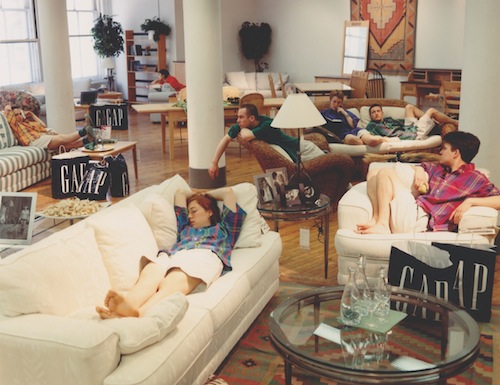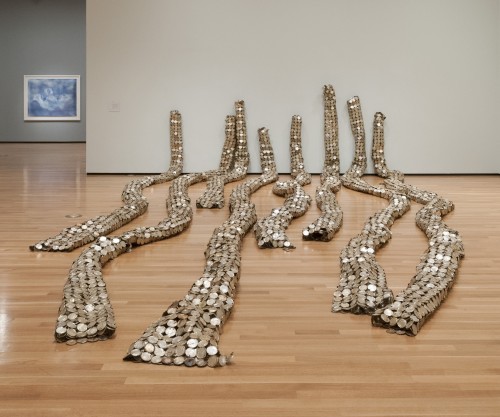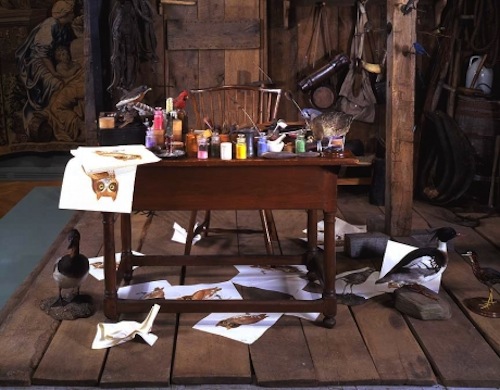
John Currin. “Girl in Bed,” 1993. Oil on canvas. © John Currin. Courtesy Gagosian Gallery. Photograph: Robert McKeever.
We’re a couple of weeks into the new year, and so in the interest of getting organized, here’s a preview of what to see in New York in the upcoming months:
New Museum: NYC 1993: Experimental Jet Set, Trash and No Star (February 13–May 26, 2013)
The 1990s, which can still feel very relevant if you associate that time with being twenty, has now become a subject of historical study. Have we really reached this place? The New Museum is mounting a massive five-floor survey, entitled, NYC 1993: Experimental Jet Set, Trash and No Star, for those of you who recognize the Sonic Youth album title. The exhibition is focused on that pivotal year in which a decade begins shaking off its predecessor (the tenacious eighties, in this case—its overblown fashions, $$, angular haircuts, and hard-edged living) and establishing its own identity.

Art Club 2000. “Untitled (Conrans I),” 1992–93. Chromogenic color print. Courtesy the artist and the Estate of Colin de Land.
The Clinton nineties, what I still think of mistily as the gentle nineties, are refracted through the lens of their emerging artists, who take on global and national events (Waco, Texas; the LGBT March on Washington), and the irreverent dialogue between mainstream and underground. NYC 1993 promises to include reconstructions of exhibitions and installations from that year, and to trace an artistic trajectory reaching forward to the present. As if that isn’t exciting enough, here is just a small sample of the participating artists: Glenn Ligon, Janine Antoni, Matthew Barney, Cindy Sherman (the four of whom are featured on Art21), Robert Gober, Nan Goldin, Larry Clark, Nari Ward, Coco Fusco, David Hammons, Andrea Fraser, and John Currin.
Brooklyn Museum: Gravity and Grace: Monumental Works by El Anatsui (February 8–August 4, 2013)

El Anatsui. “Drainpipe,” 2010. Tin and copper wire, installation at the Akron Art Museum. Courtesy of the artist and Jack Shainman Gallery, New York. Photograph by Andrew McAllister, courtesy of the Akron Art Museum
El Anatsui (b. 1944, Ghana) uses discarded metals, often liquor bottle caps joined by copper wire, transforming them into massive sculptures—undulating multicolored surfaces that appear both organic and manmade, ethereal and weighty, and which suggest histories of postcolonial economic exchange in Africa, as well as abstraction in African and European art. The sculptures’ movement and mutability are built into their construction; the artist alters them depending on where they are installed, putting faith in the process of change. The Brooklyn Museum exhibition, his first solo exhibition at a New York museum, will include more than 30 works in metal and wood. For a closer look into El Anatsui’s practice and his workshop in Nigeria, see the Art21 episode “Change.”
Pace Gallery: Song Dong: Doing Nothing (January 18–February 23, 2013)
A twenty-year survey of the Chinese conceptual artist Song Dong (b. 1966, China), whose work investigates impermanence and the Taoist concept of “non-intention,” the futility, absurdity, and overall necessity of human activity. Among the works that will be on view is Breathing (1996), in which Song lay on the pavement in Tiananmen Square and used his breath to create a small patch of ice, his individualized and fleeting mark there.
Tanya Bonakdar: Mark Dion (February 28–April 13, 2013)

Mark Dion. “Alexander Wilson Studio” (detail), 1999. Wooden structure with taxidermic specimens, sketches, and miscellaneous objects from the Carnegie Museum Collection. Installation view: Carnegie International 1999/2000, Carnegie Museum of Art, Pittsburgh, Pennsylvania. Courtesy Tanya Bonakdar Gallery, New York
Art21 artist Mark Dion’s (b. 1961, U.S.) installations and recreations of interiors draw on specific social histories and the cultural vernacular, which he approaches methodically, like an archaeologist. It’s visually exciting work—even the most bizarre juxtapositions of materials have a fascinating internal logic to them.
Brooklyn Museum: LaToya Ruby Frazier: A Haunted Capital (March 22–August 11, 2013)
Frazier’s (b. 1982, U.S.) direct and arresting portraits have a way of lodging themselves in the consciousness. In this upcoming exhibition of approximately forty photographs, she explores the industrial decline of her hometown of Braddock, Pennsylvania, and the intimate repercussions on her family members and community. Frazier talks about this at length in Art21’s documentary film series New York Close Up.
Looking ahead to the fall…
MoMA: Magritte: The Mystery of the Ordinary, 1926–1938 (September 22, 2013–January 12, 2014)

René Magritte. “The Lovers,” 1928. Oil on canvas. Gift of Richard S. Zeisler. © 2012 C. Herscovici, Brussels / Artists Rights Society (ARS), New York
René Magritte (b. 1898, Belgium) has long been one of my favorite painters for reasons that feel so mysteriously personal I don’t even understand them. He speaks the language of the subconscious, which is also the language of creating—that moment before beginning, when the idea still resides within the organizational jurisdiction of the creative mind, in emblematic, identifiable pieces, joined by its own connective tissue of logic. These are paintings that make me want to paint. Magritte is not that easy to find in New York; a few pieces in MoMA’s permanent collection—and with the exception of The False Mirror (1928), these often seem to be rotated out when I show up, hopefully approaching the spot where they’re usually installed. It’s much easier to see major surrealist works by Dali or Tanguy—with whom, I, at least, don’t share the same bond. MoMA’s exhibition presents 80 works by Magritte: paintings, collages, and objects, along with ephemera positioned at the critical years of his breakthrough into surrealism. I will see you there.
LAST CALL for Christian Marclay’s The Clock, a mesmerizing, completely addictive experience at MoMA, which closes next Monday, January 21. See Max Weintraub’s fascinating review of this film montage that uses our own clock-watching against us, subverting the illusion of suspended time that we expect in the dark confines of the theater.
I welcome thoughts, ideas, show announcements. Please email me at [email protected].




Pingback: Week in Review | Art21 Blog